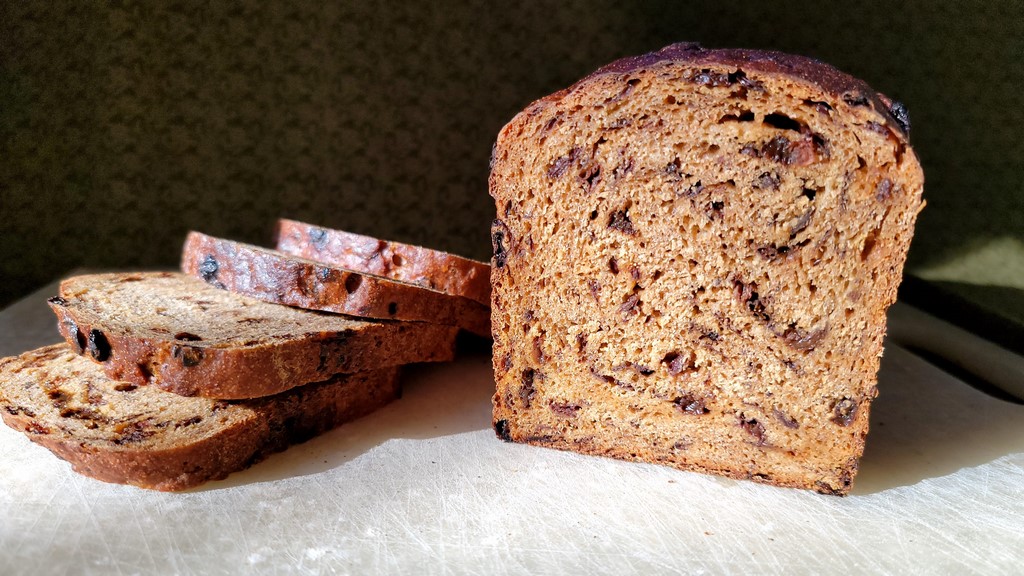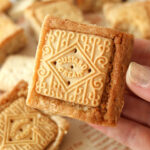Years ago there was a post in the Breadtopia forum asking if anyone knew the recipe for rye raisin rolls from Poilâne Bakery in France. The description of these rolls was intriguing: chewy, hearty and packed with currants.* Years later, when my sister gave me the book Poilâne: The Secrets of the World-Famous Bread Bakery, I found it contained the recipe for the loaf pan version of these rolls. In the intro to the recipe, Apollonia Poilâne describes how much she enjoyed this bread as a child, sliced and buttered and eaten on the way to school. I made a couple of variations of Poilâne’s rye loaf with currants recipe and it was a similar hit among my family and friends. I found it quite easy to have 2-3 slices of this bread and then reach for the knife to cut yet another slice!
* Currants are tiny raisins made from Black Corinth grapes. They’re also called Zante currants, and not to be confused with black or red currants, which are related to gooseberries. Zante currants are smaller than regular raisins and have a more tart prune-like flavor.
The rye loaf with currants recipe in the Poilâne book contains rye flour and a large, mostly all purpose flour sourdough starter (~50% the total flour weight). I riffed off those ingredients quite a bit in my first test bake, which was mostly buckwheat flour. Although it was tasty, I decided to stick with rye-dominance in the bread and trust the flavor know-how of a 92-year-old French bakery that, according to Wikipedia, makes bread for restaurants all over Paris as well as for the presidental palace (Palace Elysée). I did keep 1/2 cup (65 grams) buckwheat flour in my version below because I enjoy the added earthy flavor. If you don’t have access to buckwheat flour, please substitute with rye flour or whatever flour you prefer. I also increased the currants — to make the bread like a fruitcake but not a fruitcake — and dropped the 3/4 tsp active dry yeast.

Rye on the left; buckwheat on the right
One thing I kept from the original recipe that I really love is the pre-soak of the currants in boiling water. This creates a deep brown currant-water you then use to hydrate the dough, infusing the entire bread with currant flavor. The natural sugar in the currant water also enhances the Maillard reaction on the crust when you brush it on the dough just before putting it in the oven.

Straining the soaked currants
Make sure to check out the Photo Gallery after the recipe for target fermentation and other process pics.
Currant Bread with Rye and Buckwheat

Tart and sweet currants are packed into this delicious sourdough bread inspired by a classic from Poilâne Bakery in France. The rye and buckwheat flavors are complex and earthy, and the crumb is wonderfully chewy. Enjoy it plain, with butter, or paired with cheese for a sweet-and-savory combo.
Total Time
1 hour, 20 minutes
Ingredients
Currant Prep
- 260 grams currants (2 cups)
- 712 grams boiling-hot water (3 cups) for soaking the currants, reserve the liquid after draining
Final Dough
Baker’s Percentages
- 44% bread flour
- 44% rye flour
- 12% buckwheat flour
- 54-61% reserved water from the currant soak
- 22% sourdough starter
- 44% currants (dry weight)
- 2.2% salt
Instructions
- For a small Pullman pan 9 x 4 x 4 inches or medium USA pan 9 x 5 x 2.75 inches. See the recipe Notes for more information on loaf pan size.
- Put the currants in a bowl and pour the boiling water over them. Set aside to soak and cool for at least 10 minutes.
- Drain the currants in a colander over another bowl, pressing out the water with the back of your hand. Save the warm currant-water for the dough and dough wash. You most likely will not use all of this water.
- Measure out the lower end of the range for the currant water. Once it is lukewarm, under 100°F, mix it with the rest of the dough ingredients. Only add additional currant-water if needed after the damp currants are incorporated into the dough. There is no need to knead the dough or run the mixer after the ingredients are well mixed together.
- Cover and let the dough rise by about 1/3. With such a large amount of currants, the dough won’t aerate much even when well fermented. About 33% dough expansion takes 4-6 hours depending on the ambient temperature and how much the currant-water cooled before mixing.
- On a floured work surface, de-gas the dough and shape it into a tube. Place it in a greased loaf pan. I used a small Pullman pan but a medium USA pan will work too, just with more doming of the bread. Sometimes the transfer of the dough to the pan goes off without a hitch, but if not – if the dough is smeared or lopsided – push a thin spatula down the sides of the pan and adjust the dough until it is centered and has a curve to the surface. Dampen the spatula if it sticks to the dough.
- Cover and let the dough double in size, about 3-5 hours.
- Preheat the oven to 450°F.
- Brush the dough with plain water or with some of the reserved currant water for extra browning.
- Place a foil tent on the pan and bake on the middle shelf at 450°F for 15 minutes.
- Lower the oven temperature to 425°F and continue baking 30 minutes.
- Remove the foil and bake another 10-15 minutes or until the internal temperature of the bread is over 190°F.
- Let the bread cool on a rack for several hours before slicing.
Notes
This recipe fits a small Pullman pan 9x4x4 inches (144 cubic inches volume). You can also use a medium USA pan 9x5x2.75 inches (124 cubic inches volume) without changing the ingredient amounts but expect the bread to dome over the pan edge. For information on how to adjust the ingredient amounts for different pans, see this FAQ.










